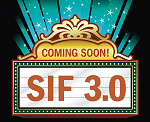SIF 3.0
- By John K. Waters
- 08/01/09
It's not here yet, but it's on the way. And what it has in
store-- full support for web services-- promises to throw
open new avenues of data integration for school districts.
 ONE OF THE EARLIEST ADOPTERS of the Schools Interoperability
Framework (SIF), Joe Kitchens, superintendent of Western Heights Public
Schools in Oklahoma City, awaits the impending arrival of its newest
adaptation. "I was there when 1.0 came out," he says, "and I'll be there
when 3.0 is released."
ONE OF THE EARLIEST ADOPTERS of the Schools Interoperability
Framework (SIF), Joe Kitchens, superintendent of Western Heights Public
Schools in Oklahoma City, awaits the impending arrival of its newest
adaptation. "I was there when 1.0 came out," he says, "and I'll be there
when 3.0 is released."
Kitchens' zeal is well founded. Six years ago, he began employing SIF, a specification
for data sharing among educational software applications, to link Western
Heights' student information system to a handful of applications, allowing integration
among the SIS and the district's nutrition, library, and gradebook programs. "We
weren't trying to be pioneers," he says. "We were just trying not to get lost in our
own data. We looked around and it just seemed to us that the SIF process was the
most promising approach to bringing together all of our multiple data sources."
The district has continued to add applications in stages.
Today that original handful has grown to 10 disparate software
applications that can share information.
The interoperability of these applications has dramatically
improved the quality of the district's data-- and saved it a ton
of money. "For every dollar we've ever put into the SIF business,
we've gotten three back in return," Kitchens says.
Now on the horizon is the approaching, though yet to be
determined release date of SIF 3.0, the next major update to
the specification. Western Heights is committed to adding
software to its systems that is SIF compliant, and this new
version (code name Columbus) is likely to give the district
more vendors to choose from-- maybe a lot more-- because
it will be arriving with a profound upgrade: full support for
web services.
What's ZIS All About?
To appreciate what web services support means in the life of
this evolving spec, you have to understand a couple of things
about the architecture that makes it work.
First proposed in 1997, the SIF is an "implementation
specification," or a kind of blueprint that describes how information
can be exchanged among applications in a K-12 setting.
The SIF architecture relies on a software server called a Zone
Integration Server (ZIS) and message gateways called agents.
Think of a ZIS as the data-integration broker among applications
that support the SIF spec. It provides a channel for transport and
for controlling access to data. SIF agents are pieces of code
that reside within a software application, or next to it, and
serve as extensions of it in interactions with each other via the
ZIS. Agents move messages to and from the message queue
and translate an application's native data model.
Like the SIF spec, web services use Extensible Markup
Language (XML) to tag data, but where the SIF agents are
tied to the ZIS architecture, web services use a more generalized
set of standards to get different types of software to talk
to each other over the internet without human intervention.
Web services are components in software applications that
allow other applications to access an app's data and capabilities
over the internet. You could also think of web services as
pieces of software that make themselves available to other
software over the internet. What matters here is that these
services also allow computer programs to share information,
data, and services, and lots of software vendors use them.
By the time the World Wide Web Consortium, an international
organization that develops standards for the web, had
offered its first definition of web services, the term was
already on the radar of the Schools Interoperability Framework
Association, the group that developed and maintains
the SIF specification and serves as the vendor certification
authority. In fact, SIFA released a web services reporting
specification in 2006, but virtually none of the educational
software vendors used it. The organization expects a different
response to the Columbus release because it will lock in the
necessary web services extensions, effectively getting everyone
on the same page.
"ISVs [independent software vendors] that have balked
at writing agents but know how to write web services-- and
there are a lot of them out there-- will be able to develop
SIF-enabled applications for the education market using any
web-service-development tool set," explains SIFA framework
architect Ron Kleinman. "This is the road to the future for us."
Kleinman emphasizes that the changes planned for SIF 3.0
are evolutionary, not revolutionary. The basic architecture
remains the same, he says; SIFA is simply opening it to web
services as well as SIF agents. He adds that the schools and
districts interested in implementing that architecture should
not wait for web services to become a part of the SIF implementation
specification.
"If you're thinking of deploying a zone or buying agents,
rest assured that they will play even in a web service zone,"
Kleinman says. "We would be crazy to betray our established
user base and walk away from thousands of deployed zones
with this release. It's not going to happen."